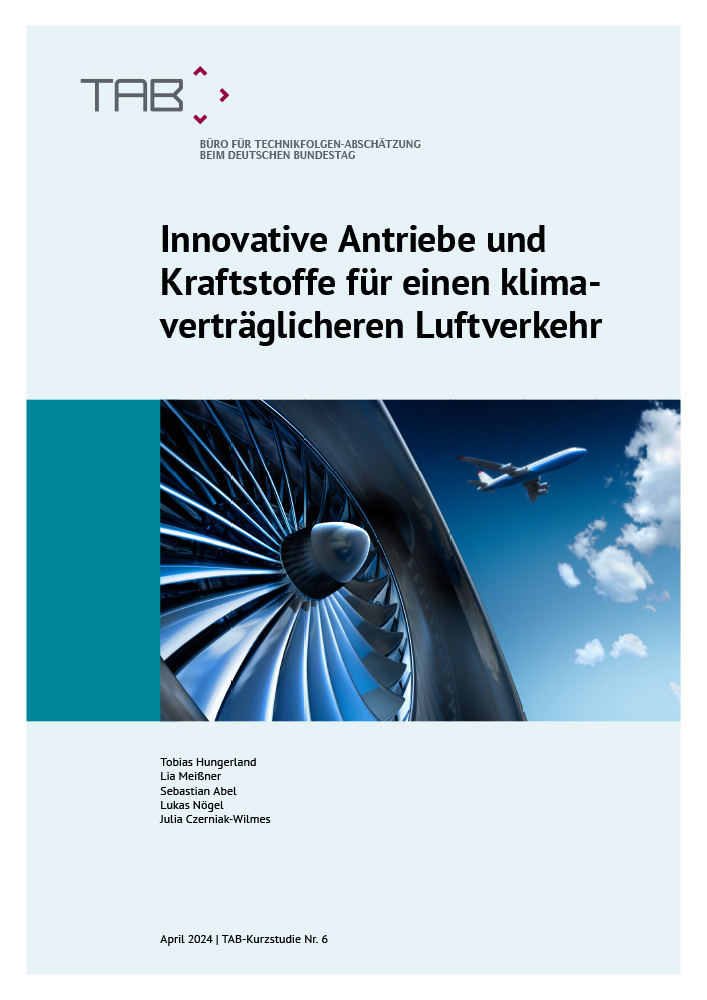Innovative engines and fuels for more climate-friendly air transport
International aviation is estimated to be responsible for around 3.5 to 5% of anthropogenic warming. In addition, climate-damaging emissions from aviation, which are caused by only a small proportion of the world's population, have roughly doubled in the last 20 years and, given the assumed growth in aviation worldwide and in Germany, could cause 60% more CO2 emissions than in 2019 if no action is taken. CO2 accounts for only about a third of the climate impact of aviation. The non-CO2 effects - soot particles, water vapour, sulphur and nitrogen oxides (NOX), which lead to the formation of condensation trails and cirrus clouds - play a much larger role, but are not yet fully understood scientifically. The climate impact also varies according to the routes flown, the altitudes at which flights are made and the aircraft used.
Ongoing activities at the European level, such as the strengthening of emissions trading or new incentives for the use of sustainable fuels, are important drivers for the further development of the international policy and regulatory framework to reduce the climate impact of aviation. For the development of climate-neutral aviation, therefore, federal policy strategies and corresponding regulation and innovation promotion play a decisive role in supporting technical innovations for the climate-friendly organisation of air traffic now and in the future.
In addition to optimising the control of conventional aircraft in the air, this includes in particular Sustainable Aviation Fuels (SAF) such as biofuels or e-fuels, for example on the basis of green hydrogen, as well as new propulsion concepts such as electric engines, hydrogen fuel cells or hybrid systems, but also new designs that take into account the requirements arising from new propulsion concepts and SAF.
The above-mentioned innovations in the fuel and propulsion sector can limit the extent of the increase in emissions and thus make aviation more climate-friendly. An innovative landscape of players is available to implement the possible solutions. Thanks to its technological leadership, the German aviation industry can play a pioneering role in the development of climate-neutral aircraft.
However, it is also clear that completely climate-neutral aviation cannot be achieved without offsetting emissions, removing CO2 from the atmosphere and avoiding flights or shifting flights to other modes of transport. And none of the concepts and strategies considered is sufficient on its own to achieve the emissions targets; instead, a combination of different measures is needed, taking into account the respective strengths and weaknesses of the innovations and the different areas of application. Sustainable fuels are the most important area of innovation with a short time horizon, as they can be used today in the existing fleet and can reduce emissions.
Measures that can be implemented in the short term to reduce emissions immediately could therefore be a reduction in the proportion of aromatics in paraffin and the introduction of a paraffin tax. Measures that will only have an effect in the medium to long term include simplifying standards and approval procedures to allow innovative solutions to develop their potential, "climate-friendly labels" to control demand for aircraft, and the creation of a reliable investment and innovation environment by policymakers.
Against the background of the political and economic framework conditions, the TAB study provides an overview of key areas of technical innovation that can contribute to more climate-friendly aviation. The focus is on the two innovation areas of fuels and propulsion concepts, which are analysed in terms of their potential and risks. Other approaches such as offsetting emissions, increasing efficiency and flight avoidance are also analysed. Finally, taking into account the social, economic, ecological and political drivers and barriers in the aviation sector, as well as an analysis of the strengths and weaknesses of the German aviation innovation system, fields of action and options for political decision-makers to shape climate-neutral aviation are identified. A detailed summary of the study with key findings can be found on the project page and in the publication.
08.05.2024
Download und weitere Informationen
- TAB-Kurzstudie Nr. 6 (only in German)
Innovative Antriebe und Kraftstoffe für einen klimaverträglicheren Luftverkehr (PDF)
doi:10.5445/IR/1000170399 - Project Page Innovative engines and fuels for more climate-friendly air transport

